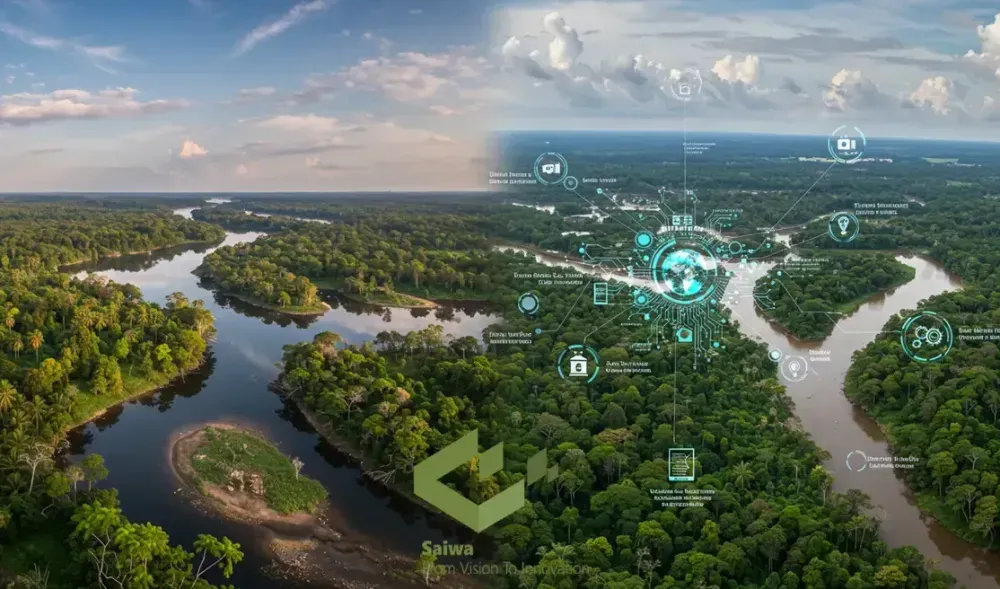Machine Learning in Environmental Science - A Sustainable Future

Environmental science addresses some of the world's most pressing challenges, including climate change, pollution, and biodiversity loss. To effectively address these issues, we need innovative tools that can process vast amounts of data, identify patterns, and accurately predict outcomes. Machine learning (ML), a powerful branch of artificial intelligence, provides the tools necessary to address these challenges in a more data-driven and efficient manner.
Sairone's AI/ML platform is an advanced solution designed to improve agricultural and environmental applications. By combining artificial intelligence with machine learning, Sairone enhances agricultural practices and supports intelligent environmental monitoring. This technology enables smarter decision-making, optimizes resources, and promotes sustainability in agriculture and ecology.
This article explores the growing role of machine learning in environmental science, focusing on its applications and how it is helping to improve sustainability and problem solving in agricultural and ecological fields.
Evolution of Machine Learning in Environmental Science
The application of machine learning in environmental science has evolved significantly over the past few decades. Early applications focused on statistical modeling and pattern recognition in machine learning, utilizing techniques like linear regression and clustering to analyze environmental data. With advancements in computing power, data storage, and algorithm development, machine learning has rapidly expanded, incorporating more sophisticated techniques like support vector machines, random forests, and deep learning.
The increasing availability of large environmental datasets, coupled with the development of powerful machine learning algorithms, has propelled the field forward, opening up new possibilities for data-driven environmental research and management.

Key Machine Learning Techniques Applied
A variety of machine learning techniques are employed in environmental science, each with its own strengths and limitations.
Supervised vs. Unsupervised Learning in Environmental Data
Supervised learning algorithms, such as regression and classification, are trained on labeled datasets, where the desired output is known. These algorithms can be used to predict environmental variables, classify different types of environmental phenomena, and identify relationships between environmental factors.
Unsupervised learning algorithms, such as clustering and dimensionality reduction, are used to explore unlabeled datasets, identifying patterns, grouping similar data points, and reducing the complexity of high-dimensional data. Both supervised and unsupervised learning techniques play important roles in environmental data analysis.
Deep Learning Architectures
Deep learning, a subfield of machine learning, utilizes artificial neural networks with multiple layers to learn complex patterns and representations from data. Deep learning architectures, such as convolutional neural networks (CNNs) and recurrent neural networks (RNNs), have shown remarkable success in image recognition, natural language processing, and other fields.
The application of these architectures has rapidly increased in the context of environmental problems. CNNs are particularly well-suited for analyzing spatial data, such as satellite imagery and remote sensing data, while RNNs are effective at analyzing time-series data, such as climate data and air pollution measurements.
Transfer Learning and its Relevance to Climate Science with Limited Data
Transfer learning, a technique where a pre-trained machine learning model is adapted for a new task, is particularly relevant to climate science, where data can be limited or expensive to collect.
By leveraging knowledge gained from related datasets or tasks, transfer learning can improve the performance of machine learning models, even with limited training data. This approach is particularly valuable for studying rare or extreme events, where historical data may be scarce.
Applications of Machine Learning in Environmental Science: Addressing Diverse Environmental Challenges
Machine learning is being applied across a wide range of environmental domains, providing valuable insights and informing decision-making.
Climate Modeling and Prediction
Machine learning is being used to improve climate models, predict future climate scenarios, and understand the complex dynamics of the Earth's climate system. ML algorithms can analyze vast climate datasets, identify patterns, and improve the accuracy of climate predictions.
Machine learning can also be used to identify key drivers of climate change, understand the impacts of climate change on different ecosystems, and develop effective climate mitigation and adaptation strategies.
Environmental Monitoring
Machine learning can automate the analysis of environmental monitoring data, anomaly detection, identifying pollution sources, and tracking environmental changes over time. ML algorithms can analyze data from sensors, satellites, and other sources, providing real-time information on air quality, water quality, and other environmental parameters.
This information can be used to inform environmental management decisions, identify pollution hotspots, and trigger early warning systems for environmental hazards.
Natural Disaster Prediction and Management
Machine learning can improve the prediction and management of natural disasters, such as floods, droughts, wildfires, and earthquakes. ML algorithms can analyze historical data, weather patterns, and other factors to predict the likelihood and severity of natural disasters.
They enable proactive mitigation measures and emergency response planning. Machine learning can also be used to assess the vulnerability of different communities to natural disasters and optimize resource allocation for disaster relief efforts.
Ecosystem and Biodiversity Conservation
Machine learning is being applied to ecosystem and biodiversity conservation, monitoring species populations, identifying endangered species, protecting habitats, and combating poaching.
ML algorithms can analyze images, acoustic data, and other sensor data to identify and track individual animals, monitor population dynamics, and detect poaching activities. Machine learning can also be used to map habitats, assess biodiversity, and predict the impacts of environmental change on ecosystems.

Integration of Machine Learning with Physical Models
Integrating machine learning with physics-based models offers the potential to improve the accuracy and interpretability of environmental predictions.
Combining ML with Physics-Based Models for Improved Accuracy
By combining the strengths of machine learning and physics-based models, researchers can develop hybrid models that leverage the predictive power of ML while incorporating the underlying physical principles governing environmental systems, such as conservation of mass, energy, and momentum.
This approach can lead to more accurate and reliable predictions, particularly in complex and dynamic environments, by constraining ML models with physical laws and incorporating prior knowledge into the learning process.
Hybrid models can also be used to improve the parameterization of physical models, leading to more realistic simulations of environmental processes.
Incorporating Physical Constraints into ML Algorithms to Ensure Consistency with Known Laws
Incorporating physical constraints into machine learning algorithms can ensure that the predictions generated by ML models are consistent with known physical laws and principles, such as thermodynamic laws or conservation principles.
This approach can improve the reliability and interpretability of ML models, preventing spurious correlations, reducing uncertainties, and ensuring that the models are grounded in scientific understanding.
By incorporating physical constraints, ML models can be used to extrapolate beyond the range of observed data and make more reliable predictions about future environmental conditions.
Challenges and Limitations
While machine learning offers immense potential for environmental science, it also presents several challenges and limitations.
Data Quality and Availability Issues in Environmental Datasets
Environmental datasets can be incomplete, noisy, and inconsistent, posing challenges for machine learning algorithms, which rely on high-quality data for training and validation. Data quality issues can limit the accuracy and reliability of ML models, introducing biases and uncertainties into the predictions.
Addressing these challenges requires robust data cleaning, preprocessing techniques, data imputation methods, and careful consideration of data limitations when interpreting ML model outputs.
Risk of Overfitting and Spurious Correlations in Complex Environmental Systems
Overfitting, where a machine learning model performs well on training data but poorly on new data, is a common challenge in environmental applications due to the complexity and high dimensionality of environmental data.
The complexity of environmental systems can also lead to spurious correlations, where variables appear to be related but are not causally linked, leading to misleading interpretations. Careful model selection, cross-validation, regularization techniques, and rigorous statistical analysis are crucial for avoiding overfitting, identifying spurious correlations, and ensuring the generalizability of ML models to new data.
Interpretability and Transparency of ML Models in Scientific Research
The "black box" nature of some machine learning models, particularly deep learning models, can make it difficult to understand how the models arrive at their predictions, limiting their utility in scientific research.
This lack of interpretability can be a barrier to adoption in scientific research, where understanding the underlying mechanisms and causal relationships is essential for advancing scientific knowledge.
Explainable AI (XAI) techniques, such as feature importance analysis, sensitivity analysis, and rule extraction, are being developed to address this challenge, providing insights into the decision-making processes of ML models and enhancing their transparency.
Computational Resource Requirements for Large-Scale ML Applications
Training and deploying large-scale machine learning models, particularly deep learning models, can require significant computational resources, including powerful processors, large memory capacity, and specialized hardware like GPUs.
This can pose challenges for researchers and practitioners with limited access to high-performance computing infrastructure, hindering the widespread adoption of advanced ML techniques.
Cloud computing, distributed computing platforms, and efficient algorithm design are emerging as solutions to this challenge, enabling access to scalable computational resources and democratizing the use of computationally intensive ML methods.

Future Directions and Opportunities: Advancing ML for Environmental Sustainability
The future of machine learning in environmental science is bright, with ongoing advancements in technology, increasing data availability, and growing awareness of its potential.
Advancements in ML Algorithms Tailored for Environmental Applications
Researchers are developing new machine learning algorithms specifically tailored for environmental applications, addressing the unique challenges posed by environmental data, such as spatiotemporal dependencies, missing values, and complex non-linear relationships.
These advancements are leading to more accurate, efficient, and interpretable ML models for environmental science, enabling more sophisticated analysis of environmental data and improved predictions of environmental phenomena. These specialized algorithms incorporate domain-specific knowledge and address the unique characteristics of environmental data.
Potential of Real-Time Environmental Monitoring with IoT and ML Integration
The Internet of Things (IoT), a network of interconnected sensors and devices, offers the potential for real-time environmental monitoring, generating vast streams of data on various environmental parameters, such as air quality, water quality, and soil conditions.
Integrating IoT and ML can provide real-time insights into environmental conditions, enabling rapid response to environmental hazards, optimizing resource management, and informing adaptive management strategies. This real-time data analysis can trigger early warning systems, automate data collection, and provide continuous monitoring of critical environmental variables.
Conclusion
Machine learning is revolutionizing environmental science, giving us the tools to tackle some of the planet's biggest challenges. Whether it's predicting climate change, managing natural disasters, or tracking biodiversity, machine learning is empowering us to make smarter, data-driven decisions that protect our environment.
While there are still challenges to overcome, the future of machine learning in this field is incredibly promising. As technology advances, data becomes more accessible, and recognition of its potential grows, the possibilities are endless.
By collaborating, using these technologies responsibly, and embracing innovation, we have the opportunity to create a more sustainable world for ourselves and future generations. The future is bright - let's harness the power of machine learning to make it even brighter.
Note: Some visuals on this blog post were generated using AI tools.
